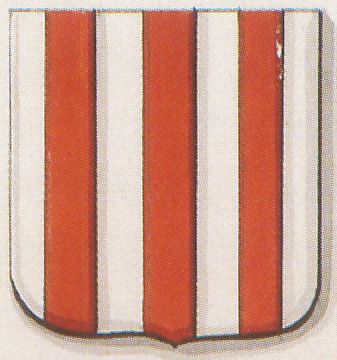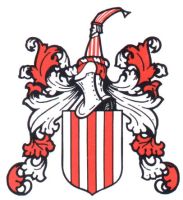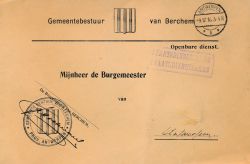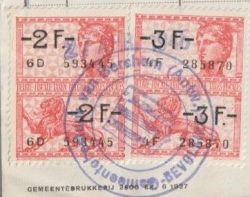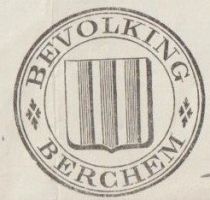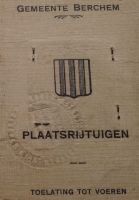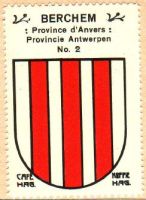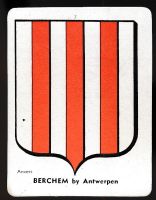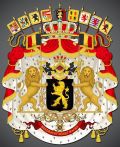Berchem (Antwerpen): Difference between revisions
Knorrepoes (talk | contribs) m (Text replacement - ".pol.jpg|center" to ".pol.jpg|center|Wapen van/Blason de {{PAGENAME}}") |
Knorrepoes (talk | contribs) m (Text replacement - " :" to ":") Tags: Mobile edit Mobile web edit |
||
| (20 intermediate revisions by the same user not shown) | |||
| Line 1: | Line 1: | ||
{{ | {| class="wikitable" | ||
''' | |- style="vertical-align:top;" | ||
|[[File:berchem1.jpg|center|alt=Wapen van {{PAGENAME}}/Arms (crest) of {{PAGENAME}}]] | |||
| | |||
<center>''' {{uc:{{PAGENAME}}}} '''</center><br> | |||
'''Country''': Belgium [[File:Belgium.jpg|60 px|right]]<br><br><br> | |||
'''Province''': <br>[[Antwerpen (provincie)|Antwerpen]][[File:Antwerp3.jpg|60 px|right]]<br><br><br> | |||
'''Incorporated into:''' | |||
* 1982 [[Antwerpen]] | |||
<br> | |||
{{#display_map:51.1940,4.4348|width=250|height=250|zoom=7}} | |||
|} | |||
{| class="wikitable" | |||
|+Official blazon | |||
|- | |||
|'''Dutch''' | |||
| | |||
*(1819) Van zilver beladen met drie roode palen. | *(1819) Van zilver beladen met drie roode palen. | ||
*(1830) Een zilveren schild met dry roode staeken. | *(1830) Een zilveren schild met dry roode staeken. | ||
|- | |||
|'''English''' | |||
| blazon wanted | |||
|} | |||
===Origin/meaning=== | |||
The arms were granted on October 6, 1819 and confirmed on May 6, 1839. | The arms were granted on October 6, 1819 and confirmed on May 6, 1839. | ||
The three red pales are derived from the arms of the Berthout family, who adopted the name Van Berchem in the 13<sup>th</sup> century, as they ruled the village at the time. Ever since the three pales have been used by the Berchem council. | The three red pales are derived from the arms of the Berthout family, who adopted the name Van Berchem in the 13<sup>th</sup> century, as they ruled the village at the time. Ever since the three pales have been used by the Berchem council. | ||
On origin of the arms there has been some debate. A local legend tells the following story :<br/> | On origin of the arms there has been some debate. A local legend tells the following story:<br/> | ||
When in the 12<sup>th</sup> century the Kingdom of Aragon (now Spain) was threatened by the Moors, the King asked for help all over Europe. The Lord of Berthout was one of the volunteers to fight the Moors. He fought very bravely and the King awarded him with a large estate and title of provincial governor. The Lord of Berthout refused and returned to Flanders.<br> | When in the 12<sup>th</sup> century the Kingdom of Aragon (now Spain) was threatened by the Moors, the King asked for help all over Europe. The Lord of Berthout was one of the volunteers to fight the Moors. He fought very bravely and the King awarded him with a large estate and title of provincial governor. The Lord of Berthout refused and returned to Flanders.<br> | ||
During a second attack several years later, the Lord of Berthout again brought victory for the King, who rewarded hem with his daughter. And again he refused and returned to Flanders.When the Moors attacked again, Berthout brought again the victory. Instead of offering a reward, the king asked Berthout what he would like to have as a reward. He answered that he would like to have the right to use the arms of [[Aragón]] (see [[Catalonia]] for the origin) as his own arms. The king accepted this, but with only three pales instead of four, as Berthout has brought three victories.<br> | During a second attack several years later, the Lord of Berthout again brought victory for the King, who rewarded hem with his daughter. And again he refused and returned to Flanders.When the Moors attacked again, Berthout brought again the victory. Instead of offering a reward, the king asked Berthout what he would like to have as a reward. He answered that he would like to have the right to use the arms of [[Aragón]] (see [[Catalonia]] for the origin) as his own arms. The king accepted this, but with only three pales instead of four, as Berthout has brought three victories.<br> | ||
The crest of the Van Berchem family shows a Moor's torso, which is also a reference to the legend. | The crest of the Van Berchem family shows a Moor's torso, which is also a reference to the legend. | ||
===Image gallery=== | |||
| | <gallery widths=250px heights=200px perrow=0> | ||
File:berchem.jpg|alt=Wapen van Van Berchem/Arms (crest) of Van Berchem family|The arms of the Van Berchem family | |||
File:Berchemc.jpg|alt=Wapen van /BerchemArms (crest) of Berchem|The arms on a municipal cover (1916) | |||
File:berchemz1.jpg|alt=Wapen van Berchem/Arms (crest) of Berchem|Municipal stamp, 1930s | |||
File:berchemb.jpg|alt=Wapen van Berchem/Arms (crest) of Berchem|The arms on a municipal letter, 1930s | |||
File:berchemt.jpg|alt=Wapen van Berchem/Arms (crest) of Berchem|The arms on a taxi permit, 1939 | |||
File:berchem.hagbe.jpg|alt=Wapen van Berchem/Arms (crest) of Berchem|The arms in the [[Koffie Hag Belgium|Koffie Hag/Café Hag albums]] +/- 1930 | |||
File:berchem.pol.jpg|alt=Wapen van Berchem/Arms (crest) of Berchem|The arms on a police badge ([http://blog.seniorennet.be/police_politie_insignes/ source]) | |||
File:2028.wi2.jpg|alt=Wapen van Berchem/Arms (crest) of Berchem|The arms on a Dutch [[Willem II]] cigar band | |||
File:Berchem.lonka.jpg|alt=Wapen van Berchem/Arms (crest) of Berchem|The arms in the [[Lonka series]] | |||
File:Berchem.bac.jpg|alt=Wapen van Berchem/Arms (crest) of Berchem|The arms on a [[BAC - Belgian arms|BAC]] sticker | |||
</gallery> | |||
| | [[Civic Heraldry Literature - Belgium|'''Literature''']]: Servais, 1955; Information provided by the Berchem District Council, 2000. | ||
{{be}} | |||
{{media}} | {{media}} | ||
[[Category:Belgian Municipal Arms B]] | [[Category:Belgian Municipal Arms B]] | ||
Latest revision as of 09:54, 22 July 2024
|
Country: Belgium Province: Antwerpen Incorporated into:
|
| Dutch |
|
| English | blazon wanted |
Origin/meaning
The arms were granted on October 6, 1819 and confirmed on May 6, 1839.
The three red pales are derived from the arms of the Berthout family, who adopted the name Van Berchem in the 13th century, as they ruled the village at the time. Ever since the three pales have been used by the Berchem council.
On origin of the arms there has been some debate. A local legend tells the following story:
When in the 12th century the Kingdom of Aragon (now Spain) was threatened by the Moors, the King asked for help all over Europe. The Lord of Berthout was one of the volunteers to fight the Moors. He fought very bravely and the King awarded him with a large estate and title of provincial governor. The Lord of Berthout refused and returned to Flanders.
During a second attack several years later, the Lord of Berthout again brought victory for the King, who rewarded hem with his daughter. And again he refused and returned to Flanders.When the Moors attacked again, Berthout brought again the victory. Instead of offering a reward, the king asked Berthout what he would like to have as a reward. He answered that he would like to have the right to use the arms of Aragón (see Catalonia for the origin) as his own arms. The king accepted this, but with only three pales instead of four, as Berthout has brought three victories.
The crest of the Van Berchem family shows a Moor's torso, which is also a reference to the legend.
Image gallery
The arms in the Koffie Hag/Café Hag albums +/- 1930
The arms on a police badge (source)
The arms on a Dutch Willem II cigar band
The arms in the Lonka series
The arms on a BAC sticker
Literature: Servais, 1955; Information provided by the Berchem District Council, 2000.
Belgium heraldry portal
This page is part of the Belgium heraldry portal |
Heraldry of the World |
|
Civic heraldry:
|
Other heraldry: |
Contact and Support
Partners:
Your logo here ?
Contact us
© since 1995, Heraldry of the World, Ralf Hartemink 
Index of the site
